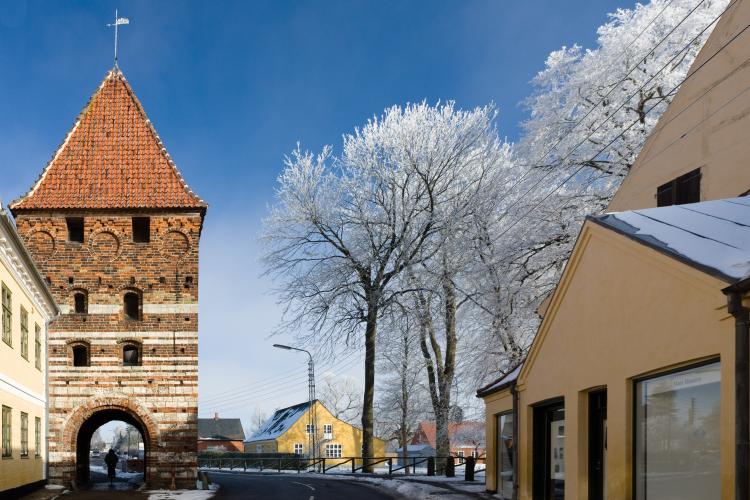Town gate and ramparts - a part of the fortifications from the 1400s
In the Middle Ages, Denmark was bristling with fortifications, several of them with moats, ramparts or walls with town gates. But only in one place has such a medieval fortification system been preserved: right here, in Stege, with its wide, beautiful and well-preserved ramparts and the town gate – Mølleporten. Stege’s town gate is one of Denmark's two preserved medieval town gates.
You have now walked around the fortifications, which were established around 1430 to protect Stege town. The ramparts went from the cove at Stege Nor around the town to the bay of Stege, thus protecting the town from attacks from land. The fortification was situated on top of the ramparts and on certain stretches of wall, probably constructed of palisades. The moat is thought to have been completely full of water. Apart from Mølleporten - which you now have in front of you – two other town gates existed: one at the end of Rådhusgade and one at the end of Langgade. Outside each town gate, a drawbridge led across the moat. For more interesting facts, read the very informative information plate next to Herring no. 7.
The years 1685-97 turned out to become the worst 12 years in Møn's history!
Colonel von Plessen, head of the Royal Life Guards, became the prefect in Møn. He brought with him 4 out of 6 military companies who all needed accommodation on the island. Plessen's time in Møn turned into a horrific regime with numerous attacks and injustices. This affected both peasants and his own people. Inside the town gate of Mølleporten, he had a prison built consisting of two bright and two dark dungeons. Today, there is nothing behind the thick walls. But wags will have it, however, that in Stege you have the world's finest and most grand pigeon loft!
In this very moment (2018), a developmental project is underway to renovate and provide access to the inside of the town gate in order for this to function as an exhibition space for Møns Museum.
On the opposite side of the ramparts lies the cemetery of Stege. Until 1812 this was situated around the church, but people were buried so close together that it started to smell quite terribly, both inside the church and in the area around it. This was a problem in many cemeteries located in towns. Nevertheless new scientific insight into hygienic conditions led to a wave of reform throughout Europe, during which new burials under cemetery floors ceased. In Denmark, a regulation in 1805 changes these matters considerably, as cemeteries in the capital and in the market towns were demanded to be moved outside the town centres.
The area where the cemetery is now situated was, for hundreds of years earlier, the place where all the mills were located. Hence, it was named Møllemarken – ‘field of Mills’. All the flour coming from here into town had always to be driven through the town gate - hence the name ‘Mølleporten – the mill gate’.
On the other side of the moat, opposite the low, white cemetery building, there is an information sign where you can see a depiction of Mølleporten with the town wall, palisade and drawbridge... an interpretation of how it might have looked back in the Middle Ages.




